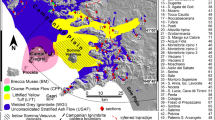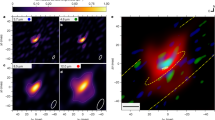Abstract
Gibson and Tazieff1 have questioned a widely accepted explanation of dense black clots of glass (fiamme) in ignimbrites. A new interpretation of these features is long overdue, for the conventional interpretation of fiamme as flattened and highly compressed lumps of pumice is very difficult to substantiate. As they point out, in many ignimbrites there are few if any lumps of pumice in the upper, uncompacted levels that are large enough to produce the dense glassy clots by compression.
This is a preview of subscription content, access via your institution
Access options
Subscribe to this journal
Receive 51 print issues and online access
$199.00 per year
only $3.90 per issue
Buy this article
- Purchase on SpringerLink
- Instant access to full article PDF
Prices may be subject to local taxes which are calculated during checkout
Similar content being viewed by others
References
Gibson, I. L., and Tazieff, H., Nature, 215, 1473 (1967).
Author information
Authors and Affiliations
Rights and permissions
About this article
Cite this article
MCBIRNEY, A. Second Additional Theory of Origin of Fiamme in Ignimbrites. Nature 217, 938 (1968). https://doi.org/10.1038/217938a0
Received:
Issue date:
DOI: https://doi.org/10.1038/217938a0
This article is cited by
-
Evidence for welding of a block and ash pyroclastic flow deposit: the case of Cerro Bravo Volcano, Colombia
Bulletin of Volcanology (2020)
-
Columnar jointing in vapor-phase-altered, non-welded Cerro Galán Ignimbrite, Paycuqui, Argentina
Bulletin of Volcanology (2011)



